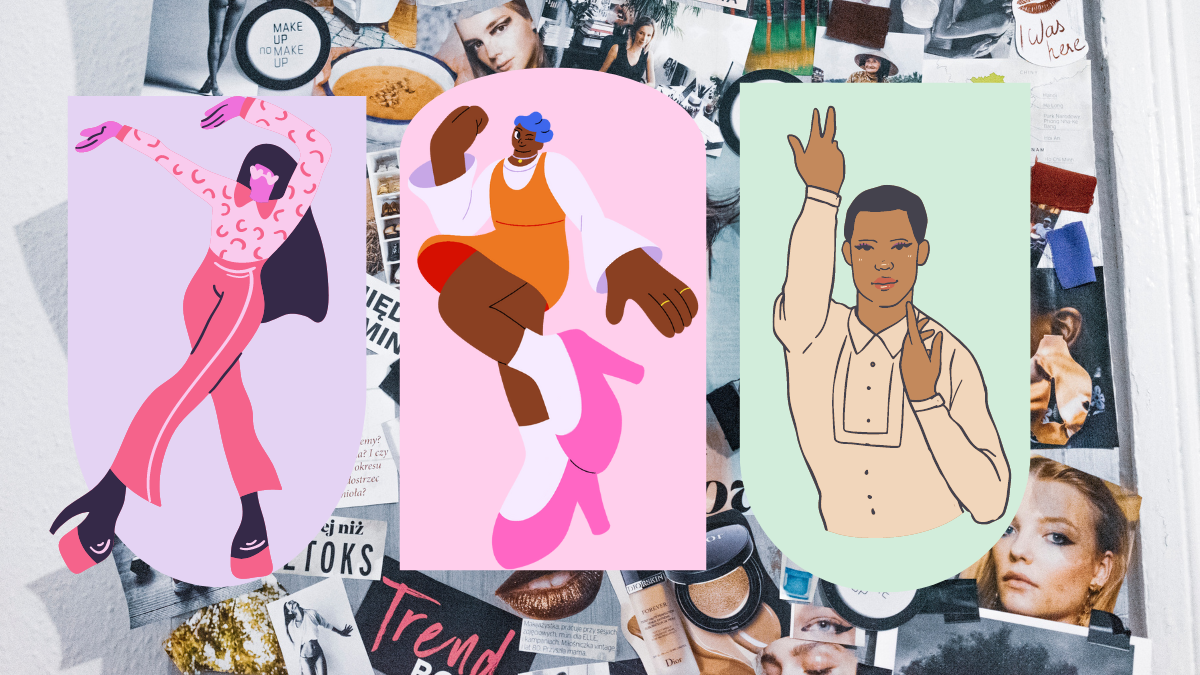By Marco Marcelline
Created by Black and Latino Trans and Queer people in Harlem, New York in the 60s, voguing has become an irrevocable part of queer history and culture in the West.
For the uninitiated, voguing evolved from New York drag competitions in the 60s known as “balls”. Named after the famous fashion magazine, it is inspired from poses in high fashion runways, with exaggerated hand gestures forming a central part of the proceedings. Various categories ranging from “Runway”, to “Vogue Fem” and “Realness” show how gender is a performance, and voguers compete for trophies and the reputation of their “Houses” – which, for many queer folk who have experienced rejection from their blood relatives, are like families.
For the Black and Latino Queers who created it, voguing, ballroom and its house culture represented a communion of love, respect and belonging in a world that was and continues to be oppressive, hostile and judgemental.

Support us!
Support us by contributing as little as £1 so we can continue to give young people a voice and a platform they deserve.
£1.00
Voguing first landed in the UK in the late 80s by way of professional dancer and choreographer Les Child, who set up The House of Child after being inspired by the voguing battles he saw in the US.
In an interview with Fact Magazine in 2014, Child, who has choreographed editorial campaigns and films for fashion houses like Burberry and Louis Vuitton, said his inspiration came from visiting New York frequently for work during the 80s. “I went to house balls there in the mid-1980s, they were these amazing events. Otherworldly was a good way of describing it! It was nothing I’d ever seen, it went on for hours.”
He recalled feeling intimidated by the house balls because they expressed a “different culture, a different attitude, a different language”, but, he added, “it was just so brilliant and so captivating. And of course, it came from the black experience.”
Roy Brown was the second core member of the House of Child. The dancer, singer, and artist discovered voguing after Child told him of his passion to put a troupe of voguers – or a ‘house’ – together. The connections Child and his House had as professional dancers and choreographers meant the House of Child was almost immediately being booked to do fashion shows, perform in videos for musicians and artists, and was even asked to model fashion accessories for the fashion brand Manolo Blahnik.
Voguing still had a very low profile in the UK throughout the latter half of the 80s, and it didn’t enter mainstream parlance until Madonna released “Vogue” in 1990, which quickly became one of her biggest-selling singles. As Les Child elaborated in his interview with Fact, while the song’s popularity ensured that suddenly everyone knew about voguing, the version that was being celebrated by the singer was “diluted, watered-down”.
That same year, the first-ever vogue ball was held in the UK. Called La Vie En Vogue, it featured performances from the original members of House of Child, including Les Child, Ray Brown, and Marc Massive, and was actually organised by British Vogue magazine.
And as Fact notes, the ball was even filmed for a documentary that was released commercially on tape (VHS).
The UK voguing scene continued through the 90s and 00s, and really took off in the 2010s thanks to the work of Jay Jay Revlon and Sydney Ultra Omni, who set up a monthly vogue night called English Breakfast London after an important club for the scene called Madame Jojo shut down. There are now at least six houses in London including Revlon (which Jay Jay is the father, and overseer of), Milan, Lanvin, Mugler, Vineyard, and Ninja.
Fast forward to today, while smaller than established European scenes in Paris, Berlin, and Amsterdam, houses exist all over the UK, with Liverpool, Bristol, Manchester, and Glasgow having the biggest scenes outside London.
Saeed, 24, found out about voguing after being invited to a practice held by House Ball Scotland by a friend who was already in the scene. “I ended up coming along, and I really liked [everyone’s] vibe, look, walk.” He attended the next practice session where he was taught how to do Vogue Fem, which he was initially uncomfortable about, though “eventually over time all that shyness went away and I just went for it.” Saeed credits ballroom for bringing out his inner confidence, noting that he is more outgoing now than he was before he started.
“When I start walking runway categories like All American, I feel like I’m a fashion model, I’ve got to show off my clothes and look expensive,” he laughs. Despite admitting that he never saw himself as a “particularly fashionable person” he says voguing has left him feeling more “confident, creative and more expressive” than ever before.
This is a sentiment shared by Anu, also at House Ball Scotland, who adds the biggest impact voguing had for them was the “sense of community” it provided that they didn’t have before and didn’t get from “usual queer spaces” which are more about a “kiki over a vodka soda”. Anu says that the wider queer community “doesn’t feel like family in the sense that ballroom community does”, noting that the latter’s emphasis on “keeping each other safe and establishing boundaries and respect” are all things that the former “could learn [from] in a big way”.
As a non-binary person, Anu has a small bone of contention with the gendered aspects of some of the categories like sex siren which they say “don’t seem inclusive enough” to non-binary people because performances are either hyper-feminine or masculine. “Where’s the space for the [people] who aren’t either, how do we walk sex siren? Because we’ve got the sex appeal”, they query.
That said, it was through voguing that Anu found other non-binary and trans people, and finds it great that trans identities in ballroom “aren’t just celebrated, they’re elevated”. Anu adds: “We call each other family and siblings, because we kind of are – whenever someone needs help, like a roof over their heads, or funding [for gender transitions], it’s a space where that’s done”.
Flora’s life has been transformed since she began her ballroom journey in 2018, and it gave her the confidence and self assurance to come out as bisexual. “I had been secretly queer for a long time and not really knowing how to come out because it was hard for people to look at a long-haired Asian woman and think anything but ‘she’s straight’, I guess.” Flora attended a practice near Edinburgh and upon trying Vogue Fem, something just “clicked” for her.
As a member of the House of Revlon, Flora is known as Saigon Revlon and they are also a free agent or 007 in the Kiki scene. “Ballroom for me is a place where I was seen as a POC and not as a subpar white person which is how I’ve been treated a lot. I was immediately seen and accepted as a Queer person of colour without question which, you’d be surprised, is not something I’ve experienced a lot of outside [of Ballroom]”, Flora adds.
One of the most significant cinematic portrayals of the ballroom scene is Paris Is Burning. Filmed in the mid to late 80s, and released in 1990, the documentary filmed the so-called “Golden Years” of the New York City drag balls. The film generated critical acclaim at the time of its release and has become a classic documentary with regular screenings continuing around the world today. Despite strong praise, the film (and particularly its maker) has come under some criticism for being of and catering to the white, external gaze.
Flora explains: “From my perspective, Paris is Burning [which was made by a white queer woman], was filmed from a very white, victimising, and trauma-porn-type lens. When I watch it, I see a little bit of voyeurism as it is filmed from an outsiders’ perspective”.
A key issue that critics have levelled at Jennie Livingston, the director of Paris With Burning, is that she profited from a film about a community she was not a part of. In a 1993 interview with The New York Times, Livingston defended her position as a white filmmaker stating “if they [the majority Black and brown ballroom community] wanted to make a film about themselves, they would not be able”. Livingston’s education and whiteness afforded her “the ability to write those grants and push [her] little body through whatever door” to make the film, she said.
She has never disclosed how much money she has made from Paris Is Burning, but has affirmed that the film, which grossed over $4 million in US cinemas alone and was made on a $500,000 budget, did not make her rich: “The truth is I live about the same as I did, except that I used to be chronically about three months late in paying the rent, and now I’m more or less on time,” she told the Times. And in a 2019 Vanity Fair feature, the filmmaker again batted away allegations that she got rich off the documentary, while the people she filmed stayed poor.
What’s obvious though is that money can’t buy the joy and exhilarating sense of freedom that Ballroom often brings to queer people who are marginalised by society. Flora notes how transformative voguing has been for her: “I’ve never been as confident as I am now, and a large part of that is due to being in ballroom and being loved and accepted by a community of people like me, and being validated in my experience. Ballroom is difficult; ballroom is competition, but for me, ballroom is being connected to others like me and that’s priceless”.
Voguing might come with some unintended side effects, Flora admits, but they’re worth it. “I currently have a spinal joint problem due to doing Vogue Fem, but I’d do it all over again,” Flora laughs, adding, “I don’t give a s*** because walking, being judged by peers at balls, just the whole experience taught me a lot about challenging myself. And it’s very much like, if I can walk a ball, there’s not a lot in life that can scare me really.”
Thanks for reading our article! We know young people’s opinions matter and really appreciate everyone who reads us.
Give us a follow on Instagram, Twitter and Facebook to stay up to date with what young people think.

